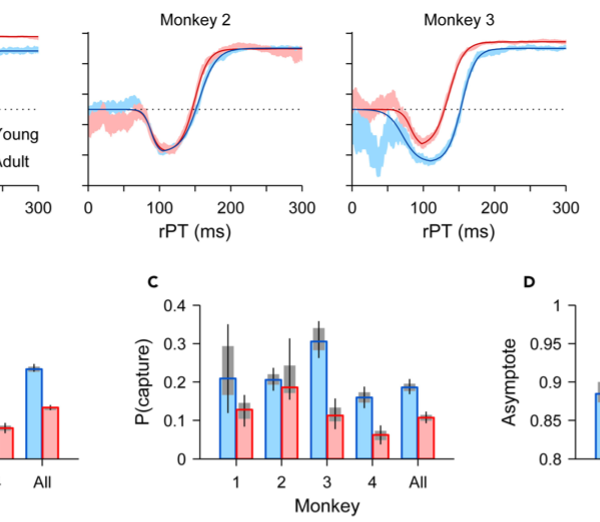Zhu, Junda; Zhou, Xin Maizie; Constantinidis, Christos; Salinas, Emilio; Stanford, Terrence R. “Parallel signatures of cognitive maturation in primate antisaccade performance and prefrontal activity.” iScience, Volume 27, Issue 8, 16 August 2024, 110488, https://doi.org/10.1016/j.isci.2024.110488.
In this study, researchers examined how our ability to control and redirect our attention develops as we grow older. They conducted their investigation by studying monkeys that were trained to disregard distractions and redirect their attention to a specific target (referred to as the antisaccade task).Through behavioral evaluations and monitoring neural activity in the prefrontal cortex, they compared the monkeys’ performance before and after puberty.
The findings revealed that adult monkeys showed significant improvements in processing the stimulus quickly, resisting the involuntary urge to look at it, and consistently following the task rules compared to when they were younger. The researchers also observed changes in the prefrontal cortex, which played a crucial role in the monkeys’ improved performance. The specific neurons in this brain region showed enhanced activity and provided neural markers of the behavioral changes, suggesting a shift from stimulus-driven to goal-driven control during each trial.
These results not only shed light on the cognitive development of monkeys but also offer important insights into how our own attentional abilities mature as we transition from adolescence to adulthood. It appears that effective allocation of attention plays a key role in achieving better response control. This study deepens our understanding of how our ability to focus and resist distractions improves over time, providing valuable knowledge about the development of cognitive skills.

(B–D) Three quantities derived from the tachometric curve and used to characterize antisaccade performance for each monkey and for their combined data (All). The rPT at criterion (B) is the processing time at which performance reaches 75% correct. The probability that a saccade is captured by the cue (C) is based on how much the tachometric curve dips below chance. And the asymptote (D) is the performance level attained at long rPTs. For all quantities, bars show values for the young (blue) and adult (red) stages, and gray shades and error bars indicate 68% and 95% CIs, respectively, obtained by bootstrapping (Methods).